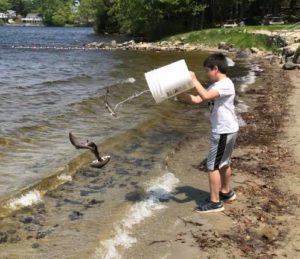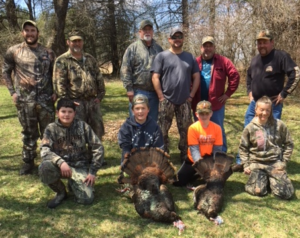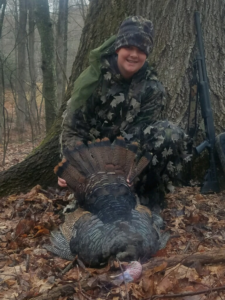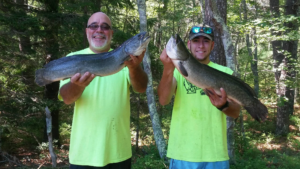Each year, the Western District of the DFW coordinates with a local public school and the Berkshire County League of Sportsmen to have students stock some fish into a local lake. The purpose of the program is to get kids who don’t normally have such an opportunity to see them up close and to get a better appreciation of them. It is an opportunity for DFW to introduce conservation ethics to them also.
This year 11 fifth graders from the Farmington River Regional School had such an opportunity, thanks to the efforts of Mark Jester, DCR District Manager – Mountain District and Rick Woodward, DCR District Manager – Lakes, for making the arrangements. The joint venture is the 4th time the three organizations teamed up to introduce kids to the outdoors. 
The youths stocked about 300 rainbow trout, all 14+ inches in length into Otis Reservoir from Camper’s Beach at the Tolland State Forest. Some of those fish were HUGE!! DFW staff would put a couple of trout into empty 5 gallon pails and the kids would run to the shore and tossed them into the water. According to DFW Aquatic Biologist Leanda Fontaine-Gagnon, stocking the fish in this manner is good for the trout as they require a little jolt to get them started.
Accompanying the students was Ms Graham, a teacher who also got into the act by also running a pail of fish to the water’s edge and sending them flying into the water.
Bass tournament
The Greylock Bass Club held a bass tournament on Onota Lake on May 13 and the results are as follows: 1st place went to Dave (DJ) Benham with a 5 fish catch weighing 17.8 lbs, 2nd Place went to Paul Procopio with 11 lbs 10 oz (5 smallmouth bass), 3rd Place went to Jim Underhill with 9 lbs 8 oz (4 largemouth bass) and tied for 4th place were Joe Chague and Rick Turczak with 7 lbs 12 oz.
According to spokesman Bill Gates, they had 10 anglers with a 30 bass total (average of 3 bass, each even though the limit is 5). After 4th place the weight averages were 1 lb per angler. With the exception of Dave’s 17 lbs, the weights were down an average of 7 lbs per angler. There were only 2 bass over 3 lbs and Dave caught both of them.
In his 40 plus years of fishing Onota lake, Bill believes that “It has never looked this environmentally terrible. There isn’t any weed growth at all and the water clarity is awful. There is a lack of sub-species, (perch, bluegill and the rock bass) of which Onota Lake is famous”. “Don’t forget”, he said, “we may not be professional bass anglers but we are very competent. Onota lake always took 18 lbs to win and for the past 25 years 90% of the participants had 5 fish limits with an average of 10 lbs or better. This is the best time of year to catch bass over 3 lbs because both largemouth and smallmouth are in the spawn or pre-spawn stage. Yet nobody found any bigger fish”.
“I know weeds are a blight to home owners and water skiers, and sculling teams hate them, but to see what is happening to the wildlife is disheartening. “I am not looking to get involved with the politics of lake management”, he said, “I’m sure somebody would come up with a well paid for study that can justify the events at Onota Lake. I, unfortunately, have to rely on my 60 years (of experience) to fall back on.”
Bill believes the above situation is caused by the annual lake drawdowns as well as the applications of herbicides.
Spring trout stocking ended
According to Western District DFW Supervisor Andrew Madden, no more spring trout stocking is anticipated this year. Many thanks go to Deb Cote, DFW Clerk, for providing us those weekly updated stocking lists. Providing those figures to us undoubtedly caused extra work for her because such information is also provided on their web site.
Please leave young wildlife alone
The following is a message from MassWildlife: The arrival of spring means the arrival of newborn and just-hatched wildlife. Every year, the lives of many young creatures are disturbed by people who take young wildlife from the wild in a well-intentioned attempt to “save” them. These well-meant acts of kindness tend to have the opposite effect. Please remember, finding a young animal alone does not mean it’s abandoned; the best thing you can do for young wildlife is to leave them alone.
Young wildlife removed from the wild are denied important natural learning experiences which help them survive on their own. Most people quickly find that they can’t care for young wildlife, and many animals soon die in the hands of well-meaning people. Young wildlife that survive human “assistance” miss experiences that teach them to fend for themselves. If these animals are released back into the wild, their chances of survival are reduced. Often, the care given to young wildlife results in some attachment to humans and the animals may return to places where people live, only to be attacked by domestic animals, or hit by cars. Some animals become nuisances and people have been injured by once-tamed wildlife.
Generally, young mammals are visited by their mother only a few times a day to avoid attracting predators to the young. For example, a nest of bunnies will only be visited by the adult female twice per day to nurse the young. The young are generally safe when left alone because their color patterns and lack of scent help them remain undetected. The same is true for fawns (young deer). Fawns are safest when left alone because their camouflaging color helps them remain undetected until the doe returns. If sympathetic people repeatedly visit a fawn, it can prolong the separation from the doe and delay needed feeding. Unlike deer, newborn moose calves remain in close proximity to their mothers who, in contrast to a white-tailed doe, will actively defend calves against danger. An adult cow moose weighing over 600 pounds will chase, kick or stomp potential predators, people included.
Only when young wildlife are found injured or with their dead mother may the young be assisted, but must then be delivered immediately to a licensed wildlife rehabilitator. Due to the difficulty in properly caring for them, there are no rehabilitators licensed to care for fawns. It is illegal to possess most wildlife in Massachusetts without a permit.
Column change – Please note
Please be advised that from now on, scheduled events (upcoming fishing derbies, youth hunts, gun courses, etc) will no longer be listed in this column. Such information should be sent to the Sports Editor, Geoff Smith at gsmith@berkshireeagle.com or his office number 413-496-6254. He will start running them during the week in the “Area Notes” section of the Sports Section whenever there are enough events to announce. I do plan to continue listing the results of the derbies, youth hunts, etc.



